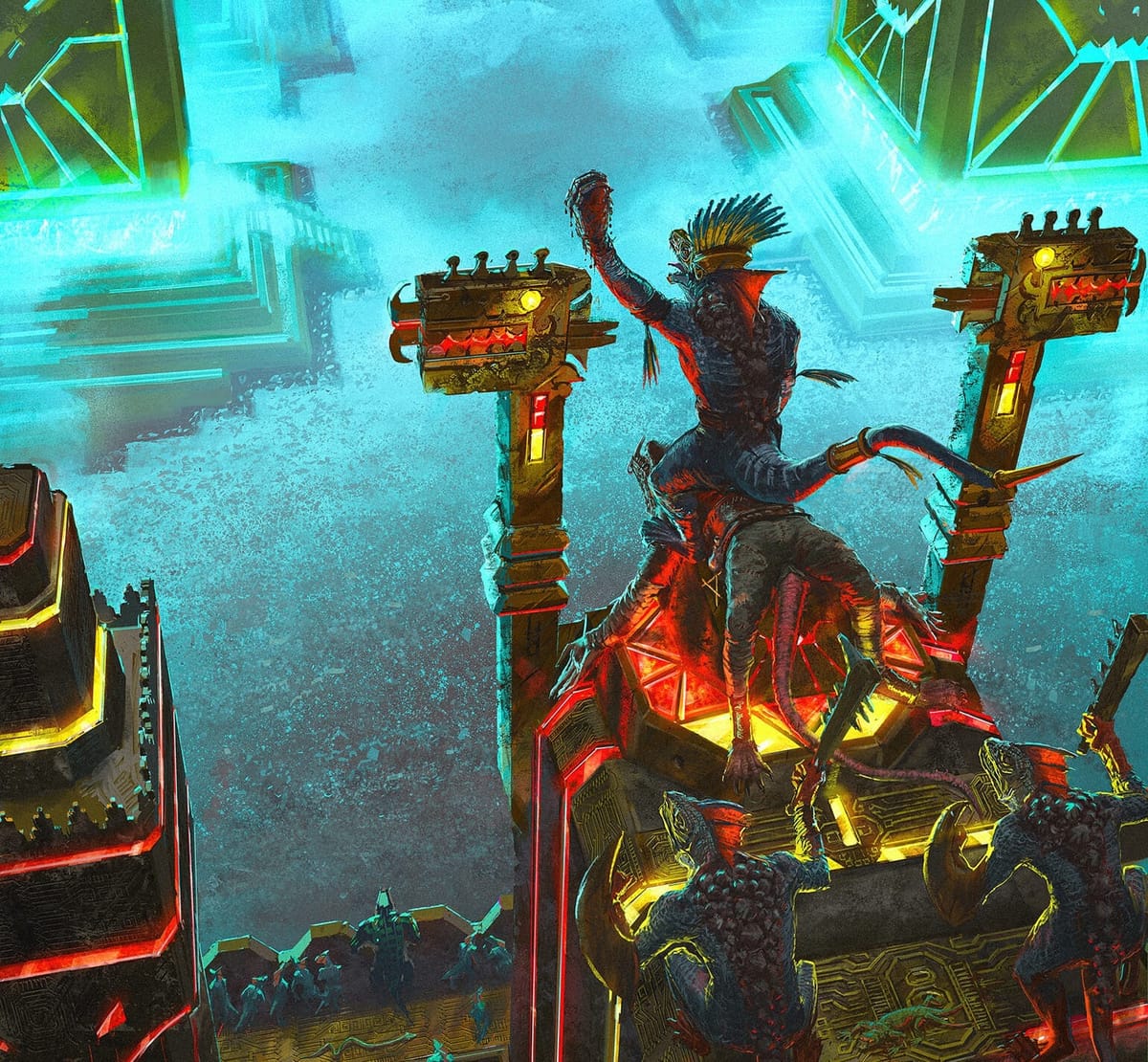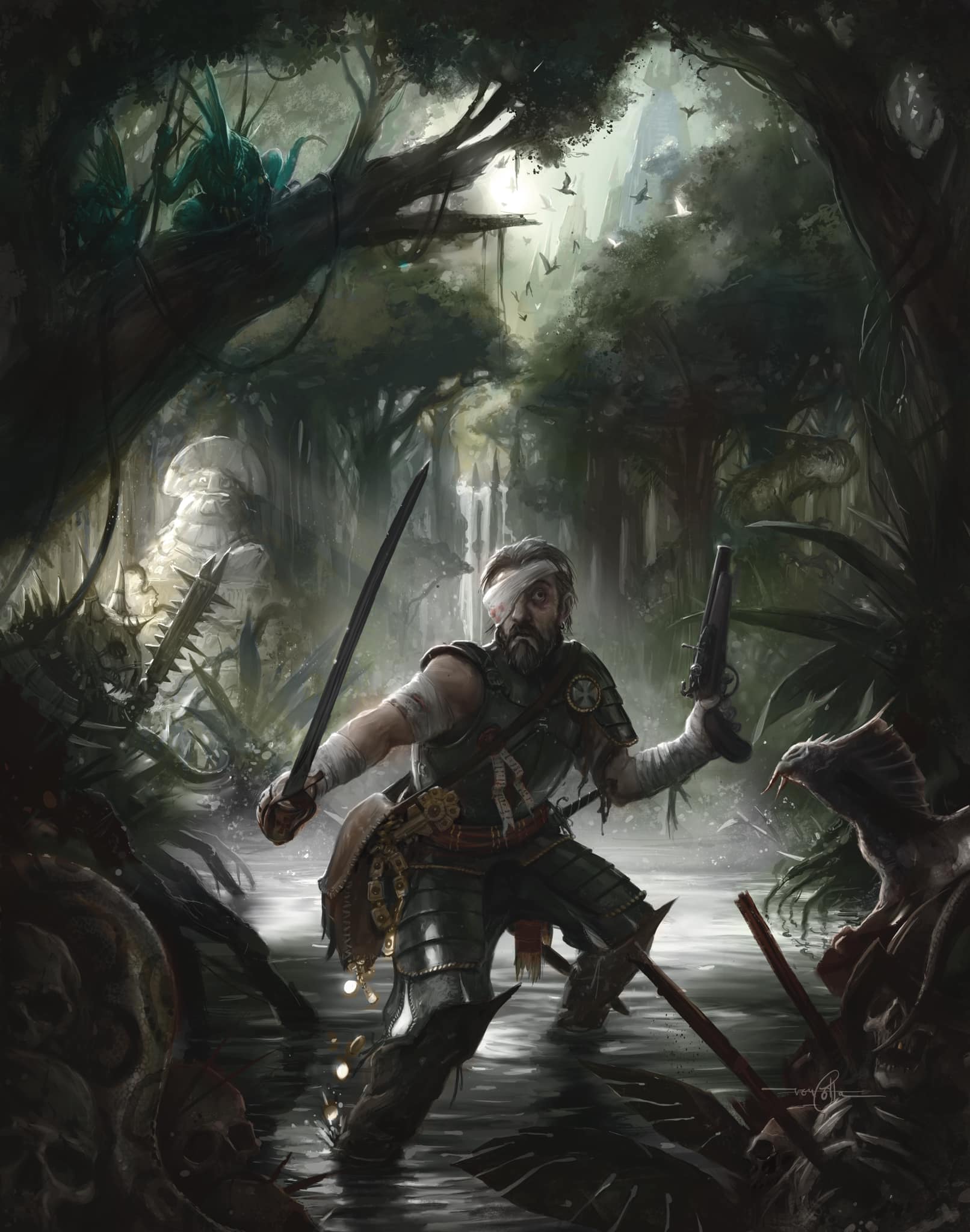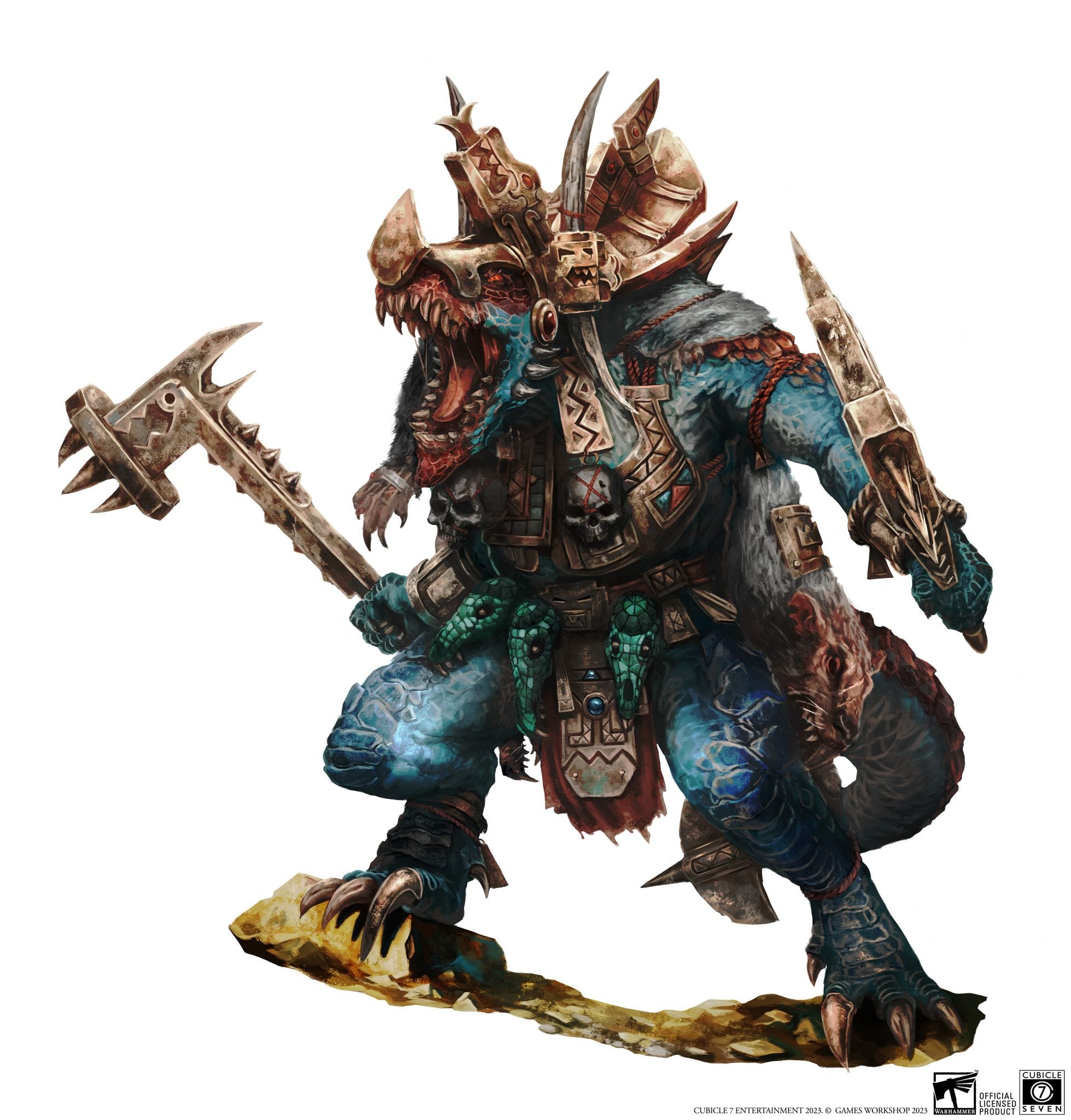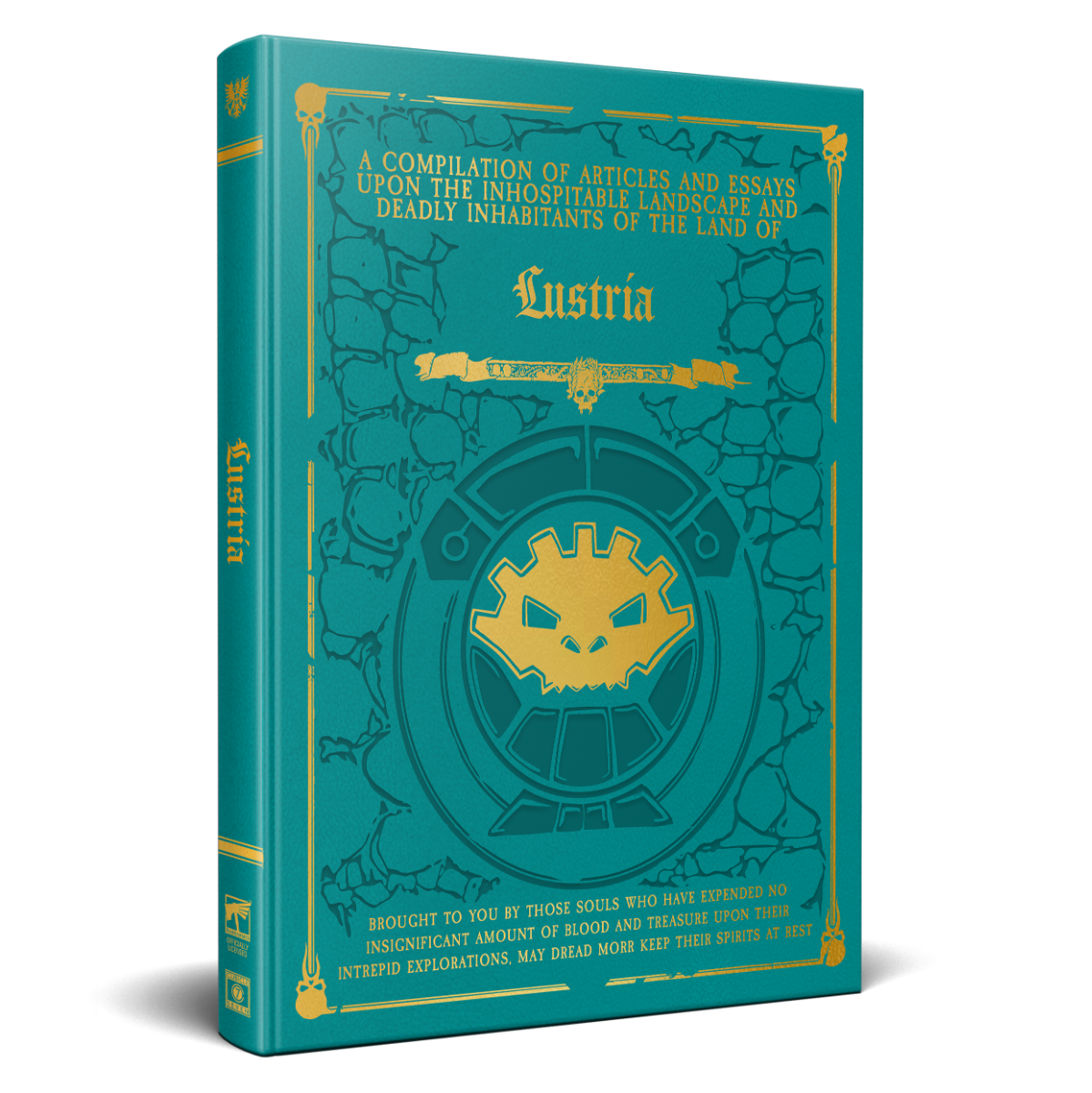
Ever since its release back in 1986 most of Warhammer Fantasy Role-Play’s focus has been on the Old World, that muddy, bloody stretch of not quite renaissance-era Northern Europe that so many of us have come to intimately know, love and die in repeatedly over the years. Whilst we’ve long known about the lands beyond the Empire, and visited them in the wargame itself, they’ve rarely, if at all, been explored in the kind of detail that only an RPG delivers. Finally that’s all beginning to change.
Having finally completed the almost-Sisyphean task of releasing the ‘Director’s Cut’ of the multi-, a staggering ten in this case, book campaign The Enemy Within, Cubicle 7 have started to look beyond the shores of fantasy not-Europe, our first stop a long awaited trip across the Great Sea to the mysterious continent of Lustria.
I say long awaited and, for once, that’s not just a writer’s hyperbole. Games Workshop first promised a sourcebook for their South American analog back in the 1980s during the WFRP’s first edition. Indeed Lustria has a bit of a special place in Warhammer history. Its first appearances pre-dating the release of the role-playing game by some margin, going right back to the earliest editions of the wargame, where it provided the backdrop to scenarios such as The Magnificent Sven that came with Warhammer Fantasy Battle’s second edition.
After several false starts though Lustria, the book, is finally here and bold, or foolhardy, adventurers can now enjoy the continent’s many sights, from its floating pyramid temples to its ruined, treasure filled, cities.
Being Warhammer though this isn’t exactly a tropical paradise rather ‘a vast death trap, subject to extreme weather, festering diseases, poisonous plants, venomous animals’ and, of course, Lustria’s most famous inhabitants, the Lizardmen, eight foot tall saurian humanoids and their enigmatic frog mage-priests, the Slann. Unsurprisingly neither are particularly keen on sharing their land with its latest warm blooded invaders.
We caught up with the game’s producer, Dave Allen to talk about the new book, completing The Enemy Within campaign and to find out a little about what’s next for the venerable RPG now that the game is moving into these new and uncharted waters. It’s fair to say that few people have a history with the game to match Allen’s, who has been involved with it in some way almost since its first release, and fewer still are better suited to shepherding it into this new age,

‘I first became aware of Warhammer Fantasy Role-Play shortly after it was released in 1986,’ he recalls. ‘I was becoming a bit too old to play with Transformers and a friend of mine had just bought the Goblin King's Chariot and plastic Skeleton Horde boxset, I was obsessed with goblins and those Kevin Adams goblins in particular.
‘The local department store that sold Citadel Miniatures also carried the [WFRP] rulebook and the modules for The Enemy Within. I remember finding it really repellent at the time, I sort of thought “why has that ogre got a mohican and what’s with all the blood spurting out of that orc’s chest” but that initial repellence grew into a bit of an obsession as I kept going back to it.’
That obsession led to the first of Allen’s several play-throughs of The Enemy Within, the acclaimed if flawed, campaign that is often cited as one of RPG’s best and which notably put as much, if not more, emphasis on politicking and intrigue as it did on your usual dungeon crawling. Like many of us who encountered it at an early age Allen admits that much of it went over his head on that first attempt but looking back he can identify many of the things that set both Warhammer and its flagship campaign apart.
‘In the late 80s we had that sort of deconstruction of geeky media going on in comic books and role playing games which The Enemy Within, either deliberately or accidentally, fell into,’ he says. ‘It was more pointedly like “this is actually quite a grim experience” right? It was the same year that Watchmen came out, which also had the same kind of rubbing your nose in the reality of what it would be like to try and do this. It was something in the air at that time.’
By the 1990s Allen had joined Games Workshop as a web developer, eventually settling at the newly launched Black Library who were then publishing the roleplaying game. Whilst working on the company’s websites he began to contribute original material for WFRP’s second edition, which eventually led to him working on Fantasy Flight Games’ third edition and then his initial freelance work with Cubicle 7 when they published the game’s current, fourth, iteration.
That long history with the game would put him in good stead as he oversaw the final stages of revamping The Enemy Within and its byzantine plots. For all its plaudits the campaign has always suffered from the rushed circumstances around its original release which led to a somewhat disappointing conclusion and, over the years, at least two, unreleased, attempts to correct it.
Cubicle 7’s ambitious new Director’s Cut of the campaign replaces the patchy penultimate book Something Rotten in Kislev with an entirely new one, The Horned Rat, and reworks the campaign’s conclusion Empire In Flames, now titled Empire in Ruins, tying up many of the loose ends left dangling by previous editions, in particular how the campaign’s later book deal with The Purple Hand, the shadowy chaos cult whose plots drive the initial plot.
Along with the five main books of the series they have also released five equally substantial ‘companion’ books, further developing the campaign and it twisting storyline of Machiavellian machinations, both daemonic and mundane, at the highest levels of The Empire. It’s a remarkable achievement but has also meant that for much of the fourth edition’s life it has been retreading old ground. Finishing this mammoth means that the game can finally look forward again, something that Allen admits has given him mixed feelings.
‘On the one hand, The Enemy Within is something that generates an awful lot of interest, and you get an awful lot of analysis of it,’ he says. ‘It's very comfortable knowing what you're doing, working on something that I genuinely enjoy and appreciate myself. A lot of that is now quite a bit harder, now we’re breaking new ground.’
Harder it may be, but it’s definitely a good time to be moving the game forward. Whilst Games Workshop may have called time on Warhammer Fantasy back in 2015, literally blowing up the world to replace it with the Age of Sigmar, the older setting is currently the most popular it has been for many years.
Much of that is due to the huge success of the Total War: Warhammer video game series. Its huge success has introduced a whole new audience to the setting many of whom will have never played the original tabletop game. Still, Cubicle 7 deserve their fair share of the plaudits too. Despite being handed a dead setting the Irish game studio have done a great job developing a new edition, updating what was best about the much loved first and second editions, without losing its unique feel.
With over 50 supplements released for it to date and a thriving community around the game, Warhammer Fantasy has, ironically perhaps, never felt more alive. Even Games Workshop are returning to it themselves with The Old World , a new rank and flank miniatures game due for release within the next year or so.
Lustria then, as Allen says, breaks new ground, our first truly in-depth look at the wider world and a hint of what might be to come and Allen and his team have combed through decades of history to pull it together.
‘It’s a sort of compilation of ideas and information from the army books and novels that have featured Lustria over the past 20 years and even further back for the occasional easter egg,’ he explains.

‘So for example, we talk about Lizardmen temple cities in general but then there’s a much more detailed description of the cities of several select Slann. We talk about the human settlements on the isthmus of Lustria, Skeggi in particular, and we talk about the Vampire Coast in some detail, the High Elf Citadel of Dawn, and Quetza, a ruined Temple City, that has been overrun by Skaven several times in the past and may still contain a few.
‘That's the background section of the book, and then we have a section that's more intended for the players. So part of that is a discussion about what different people in the Old World think about Lustria, what they know and actually just how accurate their ideas are.
‘And then we have some new careers that can play a particular role in Lustria, and what it’s like to go there, specifically how many diseases you're likely to get within the first couple of minutes of arriving, how many of the local plants can kill you, how many of the local invertebrates can kill you, all sorts of things like that. Really it’s a very dangerous place to go to and the experience of those who do is usually penury and failure. But the option’s now there if you're mad enough.’
I suspect that for those of us who have been waiting decades for the opportunity to be assaulted by the continents myriad deadly flora and fauna there will be few complaints. As we’ve come to expect from Cubicle 7 the book is filled with gorgeous art and evocative descriptions of Lustria’s deadly landscape. It may all sound horrible, but it also sounds like a great place for the kind of misadventures that Warhammer was made for.
Interestingly Lustria also not so much reintroduces but brings back to the fore many of the, somehow, even stranger parts of the Warhammer Fantasy setting that get less attention when the focus is on the realpolitik of the Empire. The book’s timeline takes us right back to some 20,000 years before the game’s present day, when hyper advanced aliens, the Old Ones, first arrived on the planet, terraformed the land and evolved many of its species, including their principal servants and the inheritors of their great plans, Lustria’s Lizardmen and Slann.
Yes, long before Space Marines were a thing Warhammer Fantasy had its own ancient astronauts. Whilst they’ve never been hidden away it’s been a while since this aspect of the setting has been giving so much prominence. This also allows the writers to indulge in some of the often terrible humour that, for all its grim dark reputation, is written through the game like a stick of rock. Take for example the Sentinels of Xeti, giant monoliths tuned to the heavens, its Skink attendants desperately listening for a transmission from the long departed old ones. To ram the pun home Xeti is, of course, overseen by the Slann mage-priest Qrl’Zy’Ken. Feel free to roll your eyes or emit a mild chuckle as appropriate.
Talking of things that are appropriate though, Allen and his team may have indulged in more than a bit of old school wordplay throughout the book but they have also been careful to update the setting’s sensibilities. For all that the RPG was groundbreaking in its depiction of the Empire as a more realised, slightly lower-fantasy setting Warhammer also revelled in being bombastic, over the top and happily embraced, stereotyped, lampooned, satirised and appropriated countless real world cultures.
When that source material has been closer to home, such as the game’s depiction of orcs as gleefully violent English football hooligans it can result in refreshingly subversive takes, but that’s certainly not always been the case. Lustria has definitely suffered from this in the past, whilst the pink haired techno-lesbian Amazons of early editions could probably work in some way today, more egregious missteps such as the continent’s pygmy inhabitants have been wisely consigned to history.
‘There are no pygmies in our Lustria,’ Allen emphatically states. ‘And as far as sensitivity issues beyond that go I feel that Games Workshop have evolved Lustria into a more mature direction. By the time they published the 2003 Lizardmen army book, I don't think there's much there that I would baulk at detailing and elaborating in a role playing game. So certainly the last 20 years, and the direction it’s been moving in, that is how we approached the new material.
‘There is some talk about the Amazons and the Norscan settlements and human habitation in general. But again, the experience of humans trying to carve out their own fiefdoms in Lustria is a terrible one and we're very much emphasising that.’

Lustria is certainly an exciting new stage for WFRP. The book not only giving players new lands to explore and more than enough barbed adventure hooks to get stuck into but flips many of the game’s established ideas on its head. The few human settlements that are eking out an existence on the continent have a very different approach to the burn first and ask questions later approach to Chaos in the Old World. Likewise for those after a very different experience there’s also rules to play Lizardmen characters, promising a very different kind of Warhammer experience.
But what then’s next for WFRP? Now that we’ve touched upon our first distant shore can we expect to see more the map filled in? Perhaps even following Total War’s long journey east to Cathay... Allen is cagey but still seems full of ideas of where he’d like to take the game next. ‘I think WFRP has benefited very much from the human-centric presentation,’ he says. ‘But I would like to look in more depth at the other species of the Warhammer world and their perspective on it. Both species that you can play with at the moment and ones that we haven't released any material for yet. So that'd be an ambition.
‘Then we should shortly be releasing Archives of the Empire Three, I think that will have a lot more focus on minor or forgotten religious perspectives that we haven't talked about for a long time, I'm interested to see how that goes down. I'm also interested to just see how people have received The Horned Rat and Empire in Ruins. I haven't heard of a lot of groups having played through them yet, obviously people are still stuck in Death on the Reik or Power Behind the Throne. So I'll be very interested to see how the fans respond to the material when it's on the table as opposed to just reading through it.’
That, of course, brings us to the question of whether we’ll ever see a new campaign on the scale of The Enemy Within.‘I would love to have the opportunity to design another large campaign, ‘ Allen says. ‘But I think there's a few different perspectives to consider. Personally do I think that such a campaign could be envisioned and written? Yeah, I think it could be. I think there are some challenges in that. Just as a sort of professional pride I don't think you would want to do another one that was very heavily invested in dungeon crawling, or sort of chase the components of an artifact and stick them back together again. That feels like it's been done a lot before.
‘So you'd need to think of a sort of USP for the campaign, and then have the will to see that through. I think where The Enemy Within really gets it right is it has a strong, intriguing hook. You're then presented with a series of sandbox environments that all sort of develop that hook more and more. Whilst there is some railroading in the campaign, it's very light, and I think most people appreciate the fact that they can muddle their way through. It'd be interesting to try and do that again with a different sort of hook. It would just be coming up with one, and then the environments within which you could develop it properly and make sure that it was as entertaining.’
Whether that comes to pass or not, it’s still an exciting time for WFRP. Dungeons & Dragons high-powered fantasy may still dominate the gaming landscape but as Allen says, pointing at the likes of Game of Thrones and Dark Souls, the ‘grim dark, or more mud and blood and guts, aesthetic is now quite predominant in geek culture.’
Looking around, it’s hard to disagree as whatever was in the air back in 1986 sure feels like it’s still with us today, the Old World is dead and now is a time of monsters.
Warhammer Fantasy Role-Play - Lustria is out now published by Cubicle 7
This feature originally appeared in Wyrd Science Vol.1, Issue 4 (April '23)

